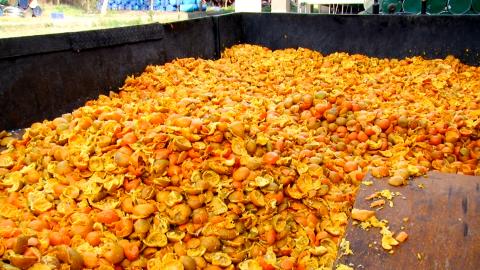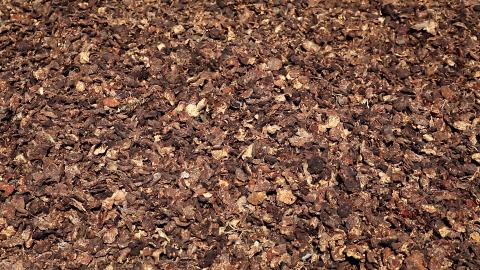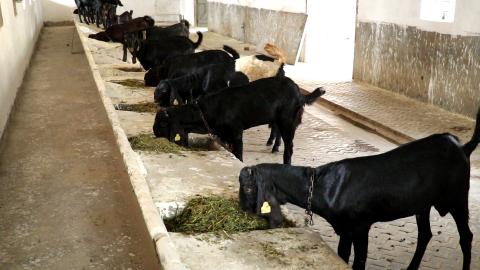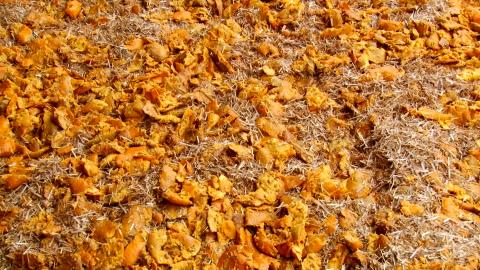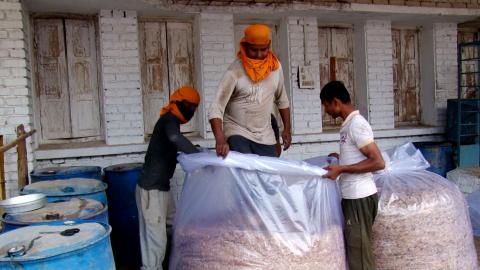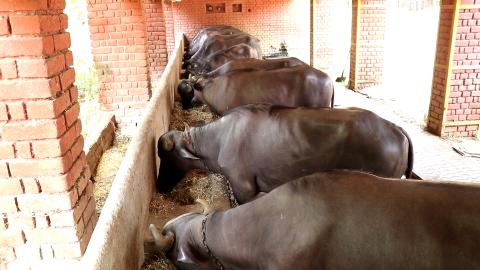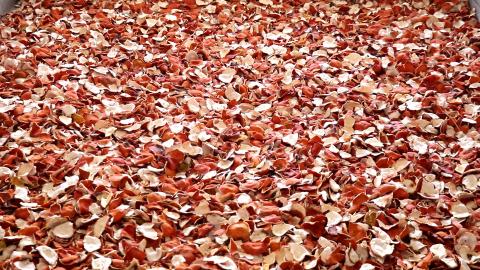Processing and utilization of kinnow wastes as livestock and poultry feed
By M. Wadhwa1, M. P. S. Bakshi1 and Harinder P. S. Makkar2
1Former Senior Nutritionist and Head, Department of Animal Nutrition, Guru Angad Dev Veterinary and Animal Science University, Ludhiana-141004, India;
2International Consultant and Adjunct Professor, University of Hohenheim, Stuttgart, Germany
Corresponding author: M. P. S. Bakshi
E-mail: bakshimps2@gmail.com
Introduction
Kinnow mandarin (Citrus reticulata Blanco) belongs to the familly Rutaceae. It is a hybrid of two citrus cultivars – ‘King’ (Citrus nobilis) and ‘Willow Leaf’ (Citrus × deliciosa). At a commercial scale, juice from citrus fruits (Mausambi/sweet lime or kinnow) is extracted in a food processing plant and is packed for future consumption. At a small scale, juice is extracted by using small-to-medium size juicers by fruit juice vendors and is consumed fresh. In the former case, kinnows procured from the orchards are brought to the food processing plant and tested for sugar content, which should not be less than 9 Brix. These are washed thoroughly with water containing 1–2% sodium hypochloride to sanitize. After sorting (removal of green and damaged kinnows) they go to ‘Rasper’ for oil extraction. The next step is the transfer of kinnows to ‘Polycitrus cutter and extractor’, where kinnows are cut into two pieces and juice is extracted. The leftover material is called kinnow waste. This waste contains peels, seeds and residual pulp (Photo 1).
Photo 1. Fresh kinnow byproduct (Photo credit: M.P.S. Bakshi)
It constitutes 50% of kinnows used for extraction (Bakshi et al., 2020) and contains 60–65% peels, 30–35% internal tissues and up to 10% seeds (Ajila et al., 2012). This kinnow waste, henceforth, termed as kinnow byproduct (KBP) in this article was procured free-of-cost in bulk from Punjab Agro Juices Ltd., Hoshiarpur, India. In the latter case, the fruit juice vendors remove the peel/rind manually before extracting the juice, mainly from Mousambi/sweet lime (Citrus limetta) during summer and from kinnows during winter. The left-over material is called citrus pulp without peels (CPWP) and was also procured free-of-cost from the local market. Normally both KBP and CPWP are dumped on wastelands, causing pollution. These are invaluable sources of nutrients and bio-active compounds, and after sun drying or ensiling these can be used as a component of a total mixed ration (TMR) for dairy cattle, goats and other livestock.
Utilization of sundried kinnow byproduct
The fresh KBP was sundried on a clean concrete floor (Photo 2).
Photo 2. Sundried kinnow byproduct (KBP) (Photo credit: M.P.S. Bakshi)
The sundried ground KBP contained 91.7% organic matter (OM), 13.3% crude protein (CP), 7.1% ether extract (EE), 30.0% neutral detergent fibre (NDF), 23.3% acid detergent fibre (ADF) and 20.5% cellulose (Bakshi et al., 2020). Screening of the KBP for bio-active components revealed that it contains 7.64% saponins, 9.70% total phenols, 1.42% non-tannin phenols, 8.28% tannin phenols, 0.06% condensed tannins, 2.05% DPPH (2,2-diphenyl-1-picrylhydrazyl), 1.16% vitamin C and 0.76% flavonoids (Wadhwa et al., 2020).
In our in vitro study, the sundried finely ground KBP replaced barley grains on N-basis at 0, 25, 50, 75 and 100% levels in a concentrate mixture. The EE and cell wall constituents increased linearly with increase in the level of the KBP. The replacement of barley grains with the KBP did not affect net gas production, true OM digestibility, total and individual volatile fatty acid production, microbial biomass production and metabolizable energy (ME) availability up to 50% level of the replacement (Table 1); suggesting that the sundried ground KBP can replace barley grains in a concentrate mixture up to 50% level on N-basis without affecting nutrient utilization (Bakshi et al., 2020).
Table 1. Effect of replacing barley grains with the kinnow byproduct (KBP) on N-basis on the net gas production, digestibility, volatile fatty acid production and ME availability from concentrate mixture Source: Bakshi et al. (2020)
| Parameter | Level of KBP used to replace barley grains in concentrate mixture, % | PSE | p-value | ||||
| 0 | 25 | 50 | 75 | 100 | |||
| NGP, ml/24h/g DM | 203.1b | 201.8b | 201.8b | 193.8ab | 188.4a | 1.72 | 0.002 |
| TOMD, % | 85.8 | 86.5 | 86.0 | 87.7 | 87.0 | 1.14 | 0.499 |
| TDMD, % | 86.5 | 87.2 | 86.8 | 88.3 | 88.0 | 0.65 | 0.357 |
| PF | 1.8a | 1.8a | 1.8a | 1.9ab | 2.0b | - | 0.016 |
| ME, MJ/kg DM | 8.3 | 8.4 | 8.5 | 8.4 | 8.3 | - | 0.421 |
| MBM, g/day | 106.1b | 113.6c | 143.6e | 102.6a | 120.6d | 4.85 | <0.001 |
| Volatile fatty acids production, mM/dL | |||||||
| TVFA | 4.2b | 4.4c | 5.6e | 4.0a | 4.8d | 0.19 | <0.001 |
| Acetate (A) | 2.3a | 2.5c | 3.3e | 2.4b | 2.9d | 0.13 | <0.001 |
| Propionate (P) | 1.3b | 1.4c | 1.7d | 1.1a | 1.3b | 0.06 | <0.001 |
| Isobutyrate | 0.03a | 0.03a | 0.04b | 0.03a | 0.03a | 0.002 | <0.001 |
| Butyrate | 0.36b | 0.39c | 0.44d | 0.33a | 0.33a | 0.014 | <0.001 |
| Isovalerate | 0.08a | 0.09b | 0.10c | 0.08a | 0.09b | 0.003 | <0.001 |
| Valerate | 0.07b | 0.08c | 0.08c | 0.06a | 0.07b | 0.002 | <0.001 |
| A:P | 1.7a | 1.8b | 2.0c | 2.1d | 2.3e | - | <0.001 |
NGP-Net gas production; TOMD- True OM digestibility; TDMD- True DM digestibility; PF- Partitioning factor; ME- Metabolizable energy; TVFA-Total volatile fatty acids; MBM-Microbial biomass; Figures with different superscripts a,b in a row differ significantly; PSE- Pooled standard error.
A TMR containing the sundried KBP based concentrate mixture (level of the sundried KBP in the concentrate mixture was 50% on dry matter basis) and berseem (Trifolium alexandrinum) hay in 50:50 ratio on dry matter (DM) basis (Photo 3) was relished by goats.
Photo 3. Goat bucks eating total mixed ration (TMR) containing the sundried
kinnow byproduct (KBP) based concentrate mixture and berseem hay
(50:50 on DM basis) (Photo credit: M.P.S. Bakshi).
The berseem hay containing 19% CP can be replaced up to 50% by sundried ground empty pea pods (another waste from food processing industry after shelling peas for human consumption) containing 18.5% CP on nitrogen basis in the TMR. The TMR composed of the concentrate mixture containing the sun dried KBP and the sundried ground empty pea pods and berseem hay in 50:25:25 ratio on DM basis was extensively consumed by goat bucks. Fegeros et al. (1995) and Assis et al. (2004) reported that dried citrus pulp with peels can replace 30% and 20% concentrate in lactating dairy cattle and lactating ewes respectively, without any adverse effect on DM intake, rumen metabolites, digestibility, milk yield or milk protein and fat contents.
Utilization of ensiled kinnow byproduct
Fresh KBP and wheat straw (WS) were mixed in 80:20 ratio (KBP-WS) to obtain 34-35% DM required for making good silage. Wheat straw (140 kg) was spread on a concrete floor. Thereafter fresh KBP (560 kg) was spread on the WS and mixed manually (Photo 4).
Photo 4. Fresh kinnow byproduct (KBP) and wheat straw (WS) mixed
in 80:20 ratio (Photo credit: M.P.S. Bakshi)
For making silage, a 10-12 feet long low-density polyethylene tube of 6 feet diameter (one side tied with a nylon string) was used as a tube silo. The uniform mixture of the KBP-WS was transferred into the tube silo with simultaneous manual pressing with clean feet (Photo 5).
Photo 5. Fresh kinnow byproduct ensiled with wheat straw (Photo credit: M.P.S. Bakshi)
After thorough pressing, the polyethylene tube was tied with nylon string at the top end and ensiled for 42 days. The tube was opened and the KBP-WS silage taken out as per the daily requirement. The tube was tied again. The KBP-WS silage contained 91.3% OM, 6.5% CP, 2.45% EE, 61.6% NDF, 48.7% ADF and 34.5% cellulose on DM basis (Wadhwa et al., 2020). A 45-day feeding trial was conducted on 8 male Murrah buffalo calves (average live weight 264.0 ± 8.50 kg) to assess the effect of feeding TMR containing the ensiled KBP-WS on nutrient utilization (Photo 6). The roughage to concentrate ratio was 65:35 on DM basis. The process for making the silage can be accessed through a video at URL: https://youtu.be/L4dyMPWUgzE.
Photo 6: Buffalo calves eating total mixed ration (TMR) containing kinnow
byproduct ensiled with wheat straw (KBP-WS silage) (Photo credit: M.P.S. Bakshi)
Animals divided into two equal groups were fed either conventional TMR or TMR containing the KBP-WS silage. In the control group the TMR contained concentrate mixture, green fodder and wheat straw in 35:19.5:45.5 ratio on DM basis; while in the test group the TMR was made up of concentrate mixture, green fodder, wheat straw and ensiled KBP-WS in 35:19.5:20.5:25 ratio on DM basis. The concentrate mixture was made up of (on % air dry basis): maize 15, wheat 15, mustard cake 15, soybean meal 11, deoiled mustard cake 10, rice bran 15, Deoiled rice bran 16, mineral mixture 2 and common salt 1. The daily DM intake and digestibility of nutrients were similar in buffalo calves of both the groups (Table 2). The feeding of the KBP-WS silage based TMR did not show any adverse effect on blood profile, purine derivatives excreted in urine (a measure of microbial protein synthesis in rumen) and N-retention in buffalo calves. It was concluded that the KBP-WS silage can be safely incorporated at a level of 25% on DM basis in the ration of buffalo calves (Wadhwa et al., 2020).
Table 2. Effect of feeding total mixed ration (TMR) based on the kinnow byproduct (KBP) ensiled with wheat straw (KBP-WS silage) on dry matter intake, digestibility of nutrients and nitrogen retention in buffalo calves. Source: Wadhwa et al. (2020)
| Parameters | Control TMR | KBP-WS silage TMR | PSE | p-value |
| DM intake, kg/day | 6.2 | 6.6 | 0.28 | 0.315 |
| Digestibility of nutrients, % | ||||
| DM | 50.6 | 55.0 | 1.82 | 0.251 |
| OM | 54.2 | 58.3 | 1.74 | 0.270 |
| CP | 68.8 | 71.0 | 1.89 | 0.617 |
| NDF | 40.3 | 43.4 | 1.94 | 0.458 |
| ADF | 32.0 | 43.0 | 3.07 | 0.066 |
| Cellulose | 51.0 | 50.7 | 2.27 | 0.945 |
| Nitrogen retention, g/day | ||||
| N-intake | 135.4 | 144.0 | 3.28 | 0.211 |
| Faecal-N | 41.7 | 41.9 | 2.14 | 0.959 |
| Digestible- N | 93.7 | 102.1 | 4.35 | 0.376 |
| Urinary-N | 59.5 | 54.3 | 5.78 | 0.688 |
| N-retained | 34.2 | 47.8 | 5.40 | 0.235 |
| ABV, % | 36.9 | 46.7 | 5.91 | 0.448 |
Number of animals in each group: 4; ABV: Apparent biological value; PSE- Pooled standard error
Utilization of citrus pulp without peels
The fresh CPWP was procured from the local market and mixed manually with chaffed wheat, paddy or Trifolium alexandrinum (berseem) straw in 70:30 ratio on DM basis and ensiled for 42 days. After the stipulated period the ensiled citrus pulp with wheat straw had a pleasant odour and was readily consumed by male buffaloes. Citrus pulp enhanced overall silage quality. Best results were obtained when the CPWP was ensiled with wheat straw in 70:30 ratio (Bakshi et al., 2007). Citrus pulp without peels could meet the daily requirements of macro and micro elements for ruminants (Bakshi and Wadhwa, 2013). The concentration of trace elements is much below the safe limit for ruminants (Wadhwa and Bakshi, 2013; Wadhwa et al., 2015).
Citrus peel and/or pulp have natural antimicrobial effects. These when included in ruminant diets decreased ruminal populations of food borne pathogens such as Escherichia coli O157:H7 and Salmonella typhimurium (Callaway et al., 2011).
Utilization of kinnow peels in broiler ration
Limonin is the main bioactive phytochemical of limonoids, which is present in high amounts in citrus peels and seeds. The IUPAC name of limonin is 7,16-Dioxo-7,16-dideoxylimondiol. It is also known as limonoate D-ring-lactone and limonoic acid di-delta-lactone. Chemically, it is a member of the class of compounds known as furanolactones. Limonoids are a prominent group of secondary metabolites found in a group of highly oxygenated triterpenoid compounds (Manners, 2007; Roy and Saraf, 2006; Zhao et al., 2008). Many studies have shown that limonoids exhibit a number of biological and pharmacological activities, such as anti-carcinogenic (Tian et al., 2001; So et al., 1996), anti-obesity (Ono et al., 2011), anti-HIV (Battinelli et al., 2003), anti-oxidant (Sun et al., 2005; Mandadi et al., 2007), anti-viral (Ribeiro et al., 2008) and cholesterol lowering (Kurowska et al., 2000) properties.
Extraction of limonin
Kinnow peels, procured from the local market, were dried under shade (Photo 7) and finely ground. The bioactive compounds (limonoids, flavonoids and carotenoids) from kinnow peel powder (KPP) were extracted by supercritical fluid extraction and entrapped in solid lipid nanoparticles (SLN) (using stearic acid, tween 20 and glycerol). Both SLN and KPP contained 7.47 mg limonin/g sample. Pesticides in the extract were below the detectable limits, and it was free of aflatoxins and hydrocyanic acid.
Photo 7. Shade dried kinnow peels (Photo credit: M.P.S. Bakshi)
Impact of limonin on the performance of broilers
Two hundred one-day-old chicks were divided into 8 groups; each group contained 4 replicates of 6 chicks each in equal sex ratio. The KPP and SLN were incorporated into the iso-nitrogenous and iso-caloric diets so as to supply 0, 0.5, 1.0 and 1.5 mg limonin/bird/day. The chicks were fed the diets for 35 days in 3 phases i.e. starter (0–14 days), grower (15–21 days) and finisher (22–35 days) phase. The data revealed that feed intake of the birds fed diets supplemented with SLN was higher (p<0.01) than that of KPP supplemented feed, resulting in higher (p<0.05) gain in live weight, but without affecting feed conversion ratio (Table 3). In comparison to the control group, the gain in live weight was higher (p<0.01) and CP digestibility lower (p<0.05) in the limonin supplemented groups. Supplementation of limonin (irrespective of level or physical form) showed no adverse effect on the blood profile, except that the uric acid level was higher (p<0.05) in birds fed limonin as SLN. The data revealed that neither the level nor the physical form of limonin showed any adverse effect on live weight, dressed weight or weight of internal organs. However, supplementation of limonin beyond 1 mg/bird/day depressed (p<0.01) the dressing percentage, deboned meat yield and nutrient digestibility.
Table 3. Effect of limonin on feed intake, utilization of nutrients and performance of broilers. Source: Sethi et al. (2020)
| Parameter | Physical form of limonin (PFL)1 | Limonin levels, mg/bird/day (LL)2 | p-value | ||||||||
| KPP | SLN | PSE | Control | 0.5 | 1.0 | 1.5 | PSE | PFL | LL | PFL×LL | |
| FI/bird/day | 78.9a | 83.2b | 0.90 | 75.7a | 82.7b | 82.6b | 83.3b | 1.28 | 0.003 | 0.001 | 0.261 |
| Utilization of nutrients, % | |||||||||||
| DM | 72.4 | 72.3 | 0.47 | 74.6c | 71.8ab | 73.0bc | 70.0a | 0.68 | 0.915 | 0.007 | 0.120 |
| OM | 77.9 | 77.7 | 0.39 | 79.6c | 77.4ab | 78.3bc | 75.9a | 0.55 | 0.755 | 0.008 | 0.097 |
| CP | 64.2b | 61.2a | 0.84 | 70.2c | 59.7ab | 63.0b | 57.9a | 1.19 | 0.033 | <0.001 | 0.384 |
| EE | 90.2 | 89.8 | 0.37 | 91.2b | 90.8b | 90.0b | 87.9a | 0.53 | 0.536 | 0.009 | 0.160 |
| CF | 45.7a | 50.8b | 1.35 | 52.4bc | 47.4b | 55.0c | 38.2a | 1.91 | 0.028 | 0.001 | 0.001 |
| Performance of broilers | |||||||||||
| Gain in wt, g | 1372 | 1422 | 19.86 | 1292a | 1407b | 1431b | 1459b | 28.08 | 0.085 | 0.002 | 0.609 |
| FCR | 2.0 | 2.1 | 0.01 | 2.1 | 2.1 | 2.0 | 2.0 | 0.02 | 0.129 | 0.159 | 0.657 |
| Dressing, % | 60.0 | 59.7 | 0.31 | 59.6ab | 60.7b | 60.2b | 58.8a | 0.43 | 0.401 | 0.034 | 0.040 |
| Limonin in meat, µg/g | 3.7a | 25.6b | 2.36 | 0.0a | 18.2b | 20.5b | 19.9b | 3.34 | <0.001 | 0.007 | 0.006 |
1Irrespective of levels of limonin; 2Irrespective of physical form of limonin; KPP-Kinnow peel powder; SLN- solid lipid nanoparticles; FI-Feed intake; FCR-Feed conversion ratio; Figures with different superscriptsa,b,c in a row differ significantly
The bioavailability of limonin was higher (p<0.01) from SLN as compared from KPP, as is evident from higher content of limonins in meat. The limonin content in meat was higher (p<0.01) at all levels of limonin supplementation as compared with unsupplemented group. It was concluded that the nano-formulations at a level of 1.0 mg/bird/day is an effective carrier of limonin, leading to improved growth (Sethi et al., 2020).
Conclusion
Rather than dumping nutrients- and bio-active compounds-rich KBP and CPWP on the wastelands, these can be effectively utilized and converted to invaluable resources. Both these products can be conserved either by sun drying or ensiling. The sundried KBP can be incorporated up to 50% in the concentrate mixture of ruminants without any adverse impact on nutrient utilization. The fresh KBP and the CPWP can be ensiled successfully after mixing with wheat straw (WS) in 80:20 or 70:30 ratio, depending on the DM content in the KBP/CPWP. The ensiled KBP-WS can be incorporated at 25–30% on DM basis in TMR without affecting nutrient utilization. Use of the KBP or the CPWP as a component of livestock diets would also decrease feeding cost and environmental pollution.
Incorporation of limonin extracted from kinnow peels in broiler ration at a daily dose of 1.0 mg per bird resulted in limonin-containing meat, the consumption of which could possibly have human health benefits.
References
- Ajila, C.M., Brar, S.K., Verma, M., Tyagi, R.D., Godbout, S. and Valero, J.R. 2012. Bio-processing of agro-byproducts to animal feed. Critical Reviews in Biotechnology 32: 382–400.
- Assis, A.J., Campos, J.M.S., Filho, S., Queiroz, A.C., Lana, R., Euclydes, R.F., et al. 2004. Citrus pulp in diets for milking cows. 1. Intake of nutrients, milk production and composition. Revista Brasileira de Zootecnia 33: 242–250.
- Bakshi, M.P.S. and Wadhwa, M. 2013.Nutritional evaluation of cannery and fruit wastes as livestock feed. Indian Journal of Animal Science 83: 1198–1202.
- Bakshi, M.P.S., Hundal, J.S. and Wadhwa, M. 2020. Evaluation of kinnow waste as substitute of cereal grains in the concentrate mixture and empty pea pods as that of berseem hay in total mixed ration for livestock. Indian Journal of Animal Science 90: 106–112.
- Bakshi, M.P.S.,Wadhwa, M., Kaushal, S. and Ameir, A.A. 2007. In-vitro evaluation of ensiled fruit and vegetable wastes. Indian Journal of Animal Nutrition 24: 12–15.
- Battinelli, L., Mengoni, F., Lichtner, M., Mazzanti, G., Saija, A., Mastroianni, C.M. and Vullo, V. 2003. Effect of limonin and nomilin on HIV-1 replication on infected human mononuclear cells. Planta Medicine 69: 910–913.
- Callaway, T.R., Carroll, J.A., Arthington, J.D., Edrington, T.S., Rossman, M.L., Carr, M.A., et al. 2011. Escherichia coli O157:H7 populations in ruminants can be reduced by orange peel product feeding. Journal of Food Protection 74: 1917–1921.
- Fegeros, K., Zervas, G., Stamouli, S. and Apostolaki, E. 1995. Nutritive value of dried citrus pulp and its effect on milk yield and milk composition of lactating ewes. Journal of Dairy Science 78: 1116–1121.
- Kurowska, E.M., Manthey, J.A. and Hasegawa, S. 2000. Regulatory effects of tangeretin, a flavonoid from tangerines, and limonin, a limonoid from citrus, on apo B metabolism in HepG2 cells. Federation of American Societies for Experimental Biology Journal 14: A298–A298.
- Mandadi, K.K., Jayaprakasha, G.K., Bhat, N.G. and Patil, B.S. 2007. Red Mexican grapefruit: a novel source for bioactive limonoids and their anti-oxidant activity. Zeitschrift Für Naturforschung C: Journal of Biosciences, 62 (3–4): 179–188
- Manners, G.D. 2007. Citrus limonoids: analysis, bioactivity, and biomedical prospects. Journal of Agricultural and Food Chemistry 55: 8285–8294.
- Ono, E., Inoue, J., Hashidume, T., Shimizu, M. and Sato, R. 2011. Anti-obesity and anti-hyperglycemic effects of the dietary citrus limonoid nomilin in mice fed a high-fat diet. Biochemical and Biophysical Research Communications; 410 (3): 677–681.
- Ribeiro, I.A., Rocha, J., Sepodes, B., Mota-Filipe, H. and Ribeiro, M.H. 2008. Effect of naringin enzymatic hydrolysis towards naringenin on the anti-inflammatory activity of both compounds. Journal of Molecular Catalysis B: Enzymatic 52–3: 13–18.
- Roy, A. and Saraf, S. 2006. Limonoids, Overview of significant bioactive triterpenes distributed in plants kingdom. Biological & Pharmaceutical Bulletin 29(2): 191–201.
- Sethi, A.P.S., Singh, M., Wadhwa, M., Bawa, M., Wagh, R., Kaur, G., Pannu, K.S. and Sethi, R.S. 2020. Impact of kinnow peel powder and nano-limonin on the performance of commercial broilers and production of value added meat under tropical conditions. Indian Journal of Animal Science 90 (In press)
- So, F.V., Guthrie, N., Chambers, A.F., Moussa, M. and Carroll, K.K. 1996. Inhibition of human breast cancer cell proliferation and delay of mammary tumorigenesis by flavonoids and citrus juices. Nutrition and Cancer International Journal 26 (2):167–181.
- Sun, C.D., Chen, K.S., Chen, Y. and Chen, Q.J. 2005. Contents and antioxidant capacity of limonin and nomilin in different tissues of citrus fruit of four cultivars during fruit growth and maturation. Food Chemistry 93 (4): 599–605.
- Tian, Q.G., Miller, E.G., Ahmad, H., Tang, L.L. and Patil, B.S. 2001. Differential inhibition of human cancer cell proliferation by citrus limonoids. Nutrition and Cancer-International Journal 40 (2): 180–184.
- Wadhwa, M. and Bakshi, M.P.S. 2013.Utilization of fruit and vegetable wastes as livestock feed and as a substrate for generation of other value added products. Ed Harinder P.S. Makkar. Food and Agriculture Organization of United Nations. RAP Publication 2013/04, pp. 56. ISBN 978-92-5-107631-6.
- Wadhwa, M., Bakshi, M.P.S. and Makkar, H.P.S. 2015. Waste to worth: fruit wastes and byproducts as animal feed. Commonwealth Agriculture Bureau Reviews, 10: 031.
- Wadhwa, M., Hundal, J.S. and Bakshi, M.P.S. 2020. Ensiling and utilization of kinnow waste and empty pea pods as feed for buffalo calves. Buffalo Bulletin 39 (In press).
- Zhao, P.H., Sun, L.M., Liu, X.J., Cao, M.A. and Yuan, C.S. 2008. Limonoids from the root of Dictamnus radicis


